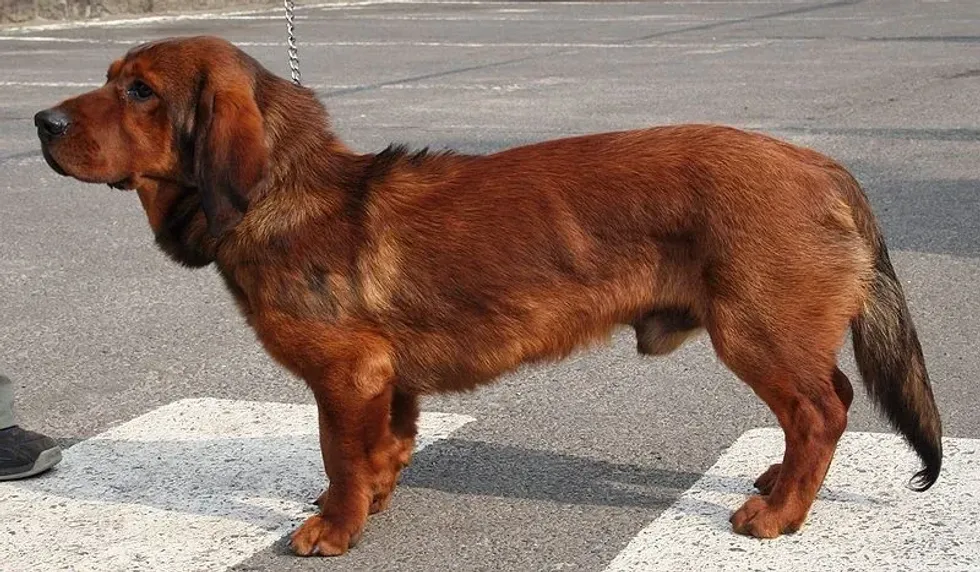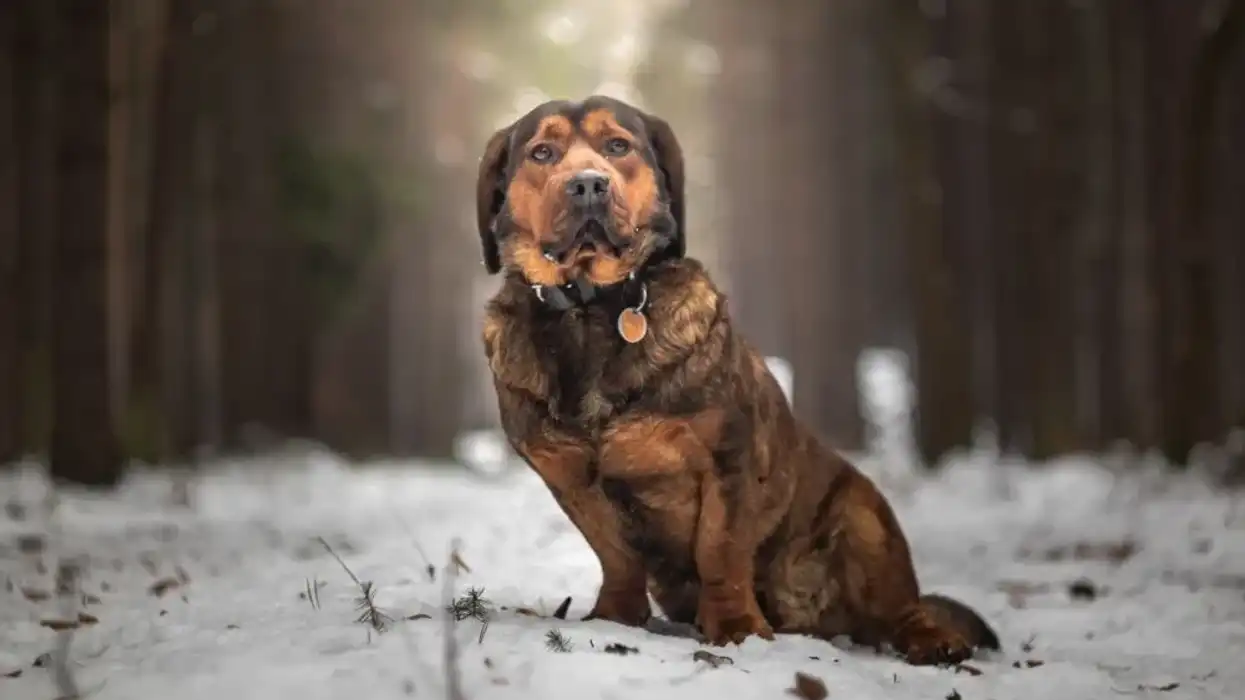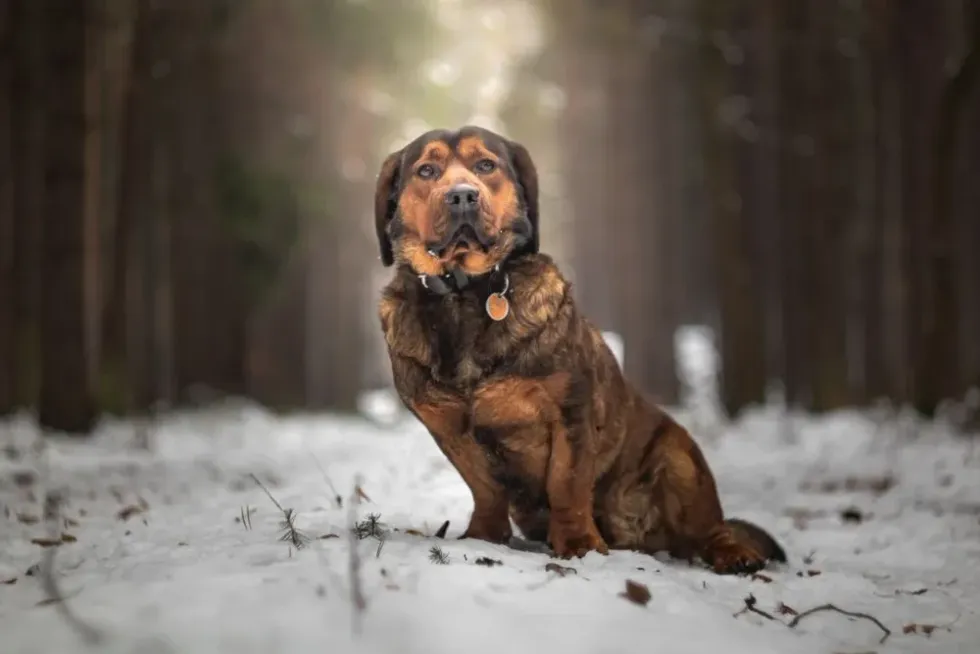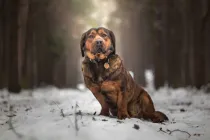Fun Alpine Dachsbracke Facts For Kids
Content
- What type of animal is an Alpine Dachsbracke?
- What class of animal does an Alpine Dachsbracke belong to?
- How many Alpine Dachsbrackes are there in the world?
- Where does an Alpine Dachsbracke live?
- What is an Alpine Dachsbracke's habitat?
- Who do Alpine Dachsbracke live with?
- How long does an Alpine Dachsbracke live?
- How do they reproduce?
- What is their conservation status?
- What does Alpine Dachsbrackes look like?
- How cute are they?
- How do they communicate?
- How big is an Alpine Dachsbracke?
- How fast can an Alpine Dachsbracke run?
- How much does an Alpine Dachsbracke weigh?
- What are the male and female names of the species?
- What would you call a baby Alpine Dachsbracke?
- What do they eat?
- Are they hypoallergenic?
- Would they make a good pet?
- Did you know...
- Why is the Alpine Dachsbracke known as a 'cold-nose hound'?
- What is Alpine Dachsbrackes a mix of?
Meet the Alpine Dachsbracke or the Alpenländische Dachsbracke in German. It’s not a disguised Dachshund or a small bloodhound.
This small dog is a cross between a Dachshund and an Austrian black and tan hound. Like its Austrian black and tan hound parent, the Alpine Dachsbracke was also first bred in Austria as a hunting dog. As a scent hound, its job was to track wounded deer, hare, boar, fox, and other big and small games.
The short-height Alpine Dachsbracke gets its fearless temperament and excellent sense of smell from its dachshund patent. Dachshunds were bred in Germany and worked to track badgers, dig, and flush them out from their burrows.
The Alpine Dachsbracke has been an asset to hunters for centuries. The breed of dogs is well-known for accompanying the Crown Prince Rudolf of Habsburg when he went for his royal hunting trips to Egypt and Turkey.
Alpine Dachsbracke has a short, dense, smooth coat in dark deer red hue and shades of red with scattered black hairs. Alpine Dachsbracke puppies are small but intelligent, obedient, loyal, and have a very loving temperament.
They are not only a good hunting dog breed but also make wonderful pets. These scent hound dogs are easily trainable and respond to firm commands.
You may also check out the fact files on the Estrela mountain dog and chihuahua from Kidadl.
Alpine Dachsbracke Interesting Facts
What type of animal is an Alpine Dachsbracke?
An Alpine Dachsbracke is a dog that’s called a scent hound. The country of origin of this hunting dog breed is Austria. It was developed for a specific hunting purpose by breeding a Dachshund with an Austrian black and tan hound.
What class of animal does an Alpine Dachsbracke belong to?
Alpine Dachsbracke are mammals. They give birth to alpine Dachsbracke puppies.
How many Alpine Dachsbrackes are there in the world?
It is difficult to tell the exact number of Alpine Dachsbrackes in the world. These small dogs were once loyal hunting companions of the Crown prince Rudolf of Habsburg. The mixed dog breed has won the hearts of people with their sweet temperament. They are kept as pets in homes around the world.
Where does an Alpine Dachsbracke live?
An Alpine Dachsbracke lives in a house with its owner and the family.
What is an Alpine Dachsbracke's habitat?
The Alpine Dachsbracke originated in Austria, where the small scent hound dog is called Alpenländische Dachsbracke. This breed was created with a purpose, and thus a big dog like the Austrian black and tan hound was crossed with a small dog breed like the Dachshund.
The newly created dog breed in the 1800s had the best of both its parent breeds. It had the strength, speed, and the strong sense of smell of its ancient hunting parent, the Austrian black and tan hound, and the short legs of the Dachshund.
That helped these scent hounds to track games and dig small animals out in high altitudes.
The alpine Dachsbracke breed has good cold-weather tolerance as it assists hunters to hunt in high mountains in cold weather. Some of these small dogs are even good at hiking and make great mountain dogs.
Who do Alpine Dachsbracke live with?
The sturdy, short hunting dogs were bred to work solo. They live with their owners in farms, urban homes, and even apartments.
Alpine Dachsbracke dogs do well with other dogs and pets and are friendly with children. These animals have a thick, short coat which, if regularly groomed, has less chance of bad smell. The Alpine Dachsbracke adjust well to apartment living with their dog parents but require daily exercise or may have an overweight problem.
The Dachsbracke Alpine dog breed has a good temperament and will remain that way with a vigorous daily exercise routine. This dog does not need a large yard to run around and can cope well with apartment living if the owner takes it for long walks, jog, run, or even hiking.
How long does an Alpine Dachsbracke live?
An Alpine Dachsbracke's lifespan is around 12 years.
How do they reproduce?
The alpine Dachsbracke breed, a cross between the bigger Austrian hounds with smaller Dachshunds, has been bred since the 19th century by the hunters. The female dogs give birth to an average litter of eight puppies.
In dog standards, it is a fairly large litter for a small dog. The Dachsbracke alpine puppies are blind at birth like all other puppies. The big round eyes, the longish floppy ears, and the cute look make these puppies adorable.
Alpine Dachsbracke puppies grow quickly and usually reach their full-grown size and height within one year. Puppies of the highly effective scent-picking hunting dog have a strong prey drive.
What is their conservation status?
The conservation status of the Alpine Dachsbracke dog breed is of the Least Concern.
Alpine Dachsbracke Fun Facts
What does Alpine Dachsbrackes look like?
Alpine Dachsbrackes have very short legs like their dachshund parent with black toenails and tight toes. They have a trotting movement. They are sturdy, firm-muscled, robust, strong-boned dogs with a longish stature.
They have a smooth topcoat. The elastic, dense coat is usually a dark deer red shade with intermittent black hairs.
Under the dense topcoat lies a thick undercoat. Both the coats are closely fitted to the body. The absence of Alpine Dachsbracke long fur in the cold alpine weather is no problem for this dog breed at all as their thick double coat is good enough to keep them warm.
The neck is thick and has strong muscles. These dogs weigh 33-40 lb (15-18 kg) and stand 13-16 in (33-40.6 cm) tall.
They have a long face with a straight nose bridge. The skull is slightly arched. The straight black nose on the long face helps these scent hounds to pick a scent that’s gone cold.
They can even pick a trail of smells in the air. Alpine Dachsbrackes have strong teeth that clamp like a scissor or a pincer when their mouth is closed or when the dogs bite.
The ideal Alpine Dachsbracke coat color is considered to be reddish-brown or dark deer red. The coat may or may not have lightly interspersed black hairs. The dogs may have dark markings on their head, chest, legs, feet, and tail.
Kennel associations like the American Rare Breed Association allow competition dogs of this breed to have a white star on the chest. The tail is long and almost touches the ground, and is thick at the base.
It has slightly rough hair. Don’t judge this small dog by its size or its short height. This breed is highly energetic and requires daily exercise, training, and early socialization like most of the hunting breeds.

How cute are they?
The short-legged Alpine Dachsbracke is a friendly dog breed with a good temperament. Although they are hunting dogs, they adapt well to living with outdoorsy families as they require a lot of exercises. They are cute and make excellent companions. These easy-to-train and simple-to-maintain dogs easily make their owners happy.
How do they communicate?
Like all other dog breeds, barking is the most prominent way of communication for Alpine Dachsbrackes. Proper training leads to an alpine Dachsbracke responding to its owner better and understanding commands. These dogs can form a firm rapport with their family members and develop a loving relationship.
These hunting dogs need daily exercise and some activities like walking and playing. Without that, they can get bored and bark excessively. This dog breed loves running in parks, fields, and woods, chasing different scents as an instinct.
How big is an Alpine Dachsbracke?
Compared to the largest Great Dane dog breed that weighs from 119 – 198 lb (54-90 kg), the Alpine Dachsbracke is about four times lighter, with its weight ranging from 33 - 40 lb (15–18 kg).
The height of Alpine Dachsbracke is about 13 in (33.2 cm) compared to the 34 in (86.3 cm) height of the Great Dane dogs.
That makes the scent hounds about two times shorter than the Great Danes.
How fast can an Alpine Dachsbracke run?
Even though Alpine Dachsbracke have short legs, as hunting dogs, they can do pretty well. The exact running speed of these dogs is not recorded.
How much does an Alpine Dachsbracke weigh?
An Alpine Dachsbracke’s average weight is 33 - 40 lb (15–18 kg), about the same size as a Labrador retriever and almost two times heavier than a Beagle.
What are the male and female names of the species?
A male Alpine Dachsbracke is called a dog, and a female is called a bitch.
What would you call a baby Alpine Dachsbracke?
A baby Alpine Dachsbracke is called a puppy.
What do they eat?
As an Alpine Dachsbracke is a hound type of dog, it should be given highly nutritious food. These medium-sized dogs must be fed a well-balanced diet. An Alpine Dachsbracke diet may include high-quality dry dog food mixed with broth, water, or even preservative-free canned food. Alpine Dachsbracke also likes to eat cooked eggs, some fruits, vegetables, cottage cheese.
However, these kinds of foods should not be a major part of the dog’s diet. Branded puppy food is better than human food for these energetic dogs.
High-quality dog food ensures a sufficient amount of vitamins and minerals in the dog’s diet. Otherwise, the dog may develop deficiencies and face health issues, tooth and bone problems.
Some dogs of this breed can be picky eaters, and some may overeat and develop obesity. It is important to keep a close watch on the dog’s diet and to feed the dog according to its size, weight, and activity level.
To maintain the good health of an Alpine Dachsbracke, its food bowl should be washed regularly, and the dogs should be provided with clean, potable water. It is important to give hunting dog breeds enough calcium in their diet.
Lack of it can lead to weak bones and hip dysplasia. Monitoring a puppy’s weight in hunting breeds is also required for preventing obesity and health issues.
Are they hypoallergenic?
The Alpine Dachsbracke dog breed is not hypoallergenic.
Would they make a good pet?
Alpine Dachsbrackes have a good, friendly, non-aggressive temperament. The loyal and affectionate nature makes them wonderful family dogs. If given its daily exercise, Alpine Dachsbrackes adapt well to apartment living too. A bored Alpine Dachsbracke can be destructive.
It is important to engage these dogs in fun games and walks. These highly energetic animals require at least thirty minutes of daily exercise. They have a natural inclination for digging, chasing, chewing, and a strong prey drive.
It is one of the healthy mixed breeds but is prone to some health conditions like an intervertebral disc, hip dysplasia, and obesity. An intervertebral disc is a common health issue for dogs with long backs and short legs.
Preventing Alpine Dachsbrackes from becoming obese can solve a lot of health issues. Another issue with such breeds is back problems on jumping from high surfaces. They are at risk of greater back injuries.
Training these small-size dogs is easy, and with proper training, they adjust well with other dog breeds. The scent-centered Alpine Dachsbracke dogs are often distracted by scents.
Early socialization and training make these small-size dogs good with all family members, including children. Alpine Dachsbracke is a less-known dog breed in the USA. A puppy of this breed may cost around $1500, and the average yearly maintenance may go up to $850 or more.
This breed of dog has an upper coat and an undercoat to keep them warm. However, the short-haired dogs shed moderately.
A weekly brushing routine helps to reduce shedding and keep the coat glossy and healthy. These dogs are not very smelly and need occasional bathing. It is important to clean an Alpine Dachsbracke’s ears.
Short training sessions fit well with these alpine dogs as they get easily distracted by smells in open spaces. They respond well to treats and praise.
Did you know...
The Alpine Dachsbracke is not a dog breed that’s recognized by the American Kennel Club. However, FCI and the UKC recognize it as a scent hound and group this breed with other scent hound dog breeds.
The only significant kennel club to recognize the Alpine Dachsbracke is the United Kennel Club (US), with the breed standard laid down by the Fédération Cynologique Internationale.
Why is the Alpine Dachsbracke known as a 'cold-nose hound'?
The Alpine Dachsbracke dog breed has a special gift. It has a strong sense of picking up a scent and following its trail, even when the scent’s gone cold.
What is Alpine Dachsbrackes a mix of?
An Alpine Dachsbracke is a mixed breed between a smaller Dachshund and a larger Austrian black and tan hound.
Here at Kidadl, we have carefully created lots of interesting family-friendly animal facts for everyone to discover! For more relatable content, check out these Australian Shepherd facts and Bull Terrier facts pages.
You can even occupy yourself at home by coloring in one of our free printable Alpine Dachsbracke coloring pages.
We Want Your Photos!
More for You
See All
Bachelor of Arts specializing in English Literature

Akinwalere OlaleyeBachelor of Arts specializing in English Literature
As a highly motivated, detail-oriented, and energetic individual, Olaleye's expertise lies in administrative and management operations. With extensive knowledge as an Editor and Communications Analyst, Olaleye excels in editing, writing, and media relations. Her commitment to upholding professional ethics and driving organizational growth sets her apart. She has a bachelor's degree in English Literature from the University of Benin, Edo State.
Disclaimer
1) Kidadl is independent and to make our service free to you the reader we are supported by advertising. We hope you love our recommendations for products and services! What we suggest is selected independently by the Kidadl team. If you purchase using the Buy Now button we may earn a small commission. This does not influence our choices. Prices are correct and items are available at the time the article was published but we cannot guarantee that on the time of reading. Please note that Kidadl is a participant in the Amazon Services LLC Associates Program, an affiliate advertising program designed to provide a means for sites to earn advertising fees by advertising and linking to Amazon. We also link to other websites, but are not responsible for their content.
2) At Kidadl, we strive to recommend the very best activities and events. We will always aim to give you accurate information at the date of publication - however, information does change, so it’s important you do your own research, double-check and make the decision that is right for your family. We recognise that not all activities and ideas are appropriate for all children and families or in all circumstances. Our recommended activities are based on age but these are a guide. We recommend that these ideas are used as inspiration, that ideas are undertaken with appropriate adult supervision, and that each adult uses their own discretion and knowledge of their children to consider the safety and suitability. Kidadl cannot accept liability for the execution of these ideas, and parental supervision is advised at all times, as safety is paramount. Anyone using the information provided by Kidadl does so at their own risk and we can not accept liability if things go wrong.
3) Because we are an educational resource, we have quotes and facts about a range of historical and modern figures. We do not endorse the actions of or rhetoric of all the people included in these collections, but we think they are important for growing minds to learn about under the guidance of parents or guardians.







